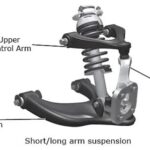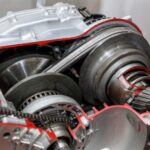In an era where vehicles are rapidly advancing, outpacing the slow march of human evolution, the question arises: what would humans look like to survive a car crash? This very question is at the heart of “Meet Graham,” a groundbreaking road safety campaign by Australia’s Transport Accident Commission (TAC) and dubbed Toward Zero. Graham isn’t just a sculpture; he’s a visceral representation of human vulnerability on the roads and a startling glimpse into a hypothetical future. Conceived by a team of experts including a crash investigation engineer, a trauma surgeon, and a renowned artist, Graham embodies the physical form humans would need to evolve to withstand the brutal forces of modern car accidents.
David Logan, a road safety engineer from Monash University’s accident research center and a key figure behind the TAC project, highlights a critical disparity: cars are evolving at a far greater rate than our biological resilience. Our bodies, remarkably adapted for many environments, are simply not built to endure the extreme energies unleashed in a car crash. These collisions inflict forces far beyond our natural capacity to absorb, leading to the alarmingly high rates of serious injuries and fatalities we see in car accidents. Graham serves as a stark visual aid, bringing this uncomfortable truth into sharp focus and prompting us to confront our physical limitations in the face of vehicular impact. He is the embodiment of What Humans Would Look Like To Survive A Car Crash if evolution kept pace with automotive technology.
The Unique Design of Graham: A Body Built for Impact
Graham is not aesthetically pleasing in the conventional sense. His design prioritizes survival over beauty, showcasing a series of deliberate physical adaptations. Imagine a body sculpted not for the runway, but for the unforgiving reality of a high-speed collision. To survive a car crash, Graham’s features are exaggerated, almost grotesque, yet each modification serves a critical protective function. His appearance – featuring a bulbous, fatty head, minimal ears, and airbag-like structures on his chest – is the embodiment of a human form re-engineered for impact resistance. He is a tangible answer to the question of what humans would look like to survive a car crash.
Fortified Skull and Face
Brain injuries are a leading cause of death and long-term disability in car accidents. To combat this, Graham is designed with an exceptionally large and thick skull. This augmented cranium is engineered to act as a helmet, absorbing and dissipating impact forces. In a crash, Graham’s skull is designed to fracture, but crucially, to fracture in a way that shields the delicate brain tissue within from critical damage. His face is also heavily fortified. A layer of fatty tissue acts as a cushion, while a concave facial structure further minimizes the risk of fractures and severe facial trauma during a collision. This facial structure is a key component of what humans would look like to survive a car crash, prioritizing brain protection above all else.
Neckless Design for Spine Protection
Whiplash and severe neck injuries are common consequences of car accidents. Graham eliminates the vulnerability of the neck entirely. By removing the neck, Graham minimizes the risk of hyperflexion and hyperextension injuries, both of which can cause devastating damage to the spinal cord. This lack of a neck, while visually striking, is a crucial adaptation in what humans would look like to survive a car crash, prioritizing spinal cord integrity and preventing paralysis or death.
Airbag-Enhanced Rib Cage and Thick Skin
Rib fractures and chest trauma are frequent injuries in car crashes, often impacting vital organs. Graham’s rib cage is reinforced with external air sacs, acting as organic airbags. These sacs are designed to deploy upon impact, filled with fluid to absorb crash energy and protect the ribs and internal organs from crushing forces. Furthermore, Graham possesses remarkably thick skin. This robust dermal layer is designed to resist lacerations and abrasions, minimizing injuries from impacts with the vehicle interior or external objects during a crash. These features illustrate further adaptations of what humans would look like to survive a car crash, focusing on torso protection.
Enhanced Legs for Pedestrian Safety
Graham’s design isn’t solely focused on protecting occupants inside vehicles. He also embodies what pedestrians would look like to survive a car crash. He features an additional joint in his lower leg, granting him increased agility and spring-like reflexes. This extra joint allows for rapid movements to evade oncoming vehicles. His knees are also engineered for extreme flexibility, designed to bend in multiple directions to reduce leg fractures and lower body injuries in pedestrian impacts. These leg modifications highlight the holistic approach to safety in considering what humans would look like to survive a car crash, extending protection beyond vehicle occupants.
The Process Behind Graham: Merging Science and Art
The creation of Graham was a collaborative endeavor, born from a deep understanding of human biomechanics in crash scenarios. David Logan’s road safety engineering expertise provided the foundational knowledge of crash forces and injury patterns. Christian Kenfield, a trauma surgeon at The Royal Melbourne Hospital, contributed critical insights into the types of injuries he frequently treats in car crash victims, informing the specific protective adaptations needed. Artist Patricia Piccinini translated these scientific and medical concepts into a tangible, albeit unsettling, physical form. Piccinini’s artistic vision brought the abstract idea of a crash-proof human to life, making the message of vulnerability and the need for road safety profoundly impactful and accessible to the public. The design process itself was a crucial step in visualizing what humans would look like to survive a car crash.
A Catalyst for Change: Road Safety and Human Limitations
The “Meet Graham” project serves as a powerful conversation starter. It underscores the critical point that despite advancements in vehicle safety technology, our bodies remain fundamentally vulnerable in car crashes. As David Logan explains, we routinely subject our bodies to speeds and forces that far exceed our biological design limits. Even seemingly low-speed collisions at 30-35 km/h can result in severe injuries. Patricia Piccinini emphasizes the project’s community relevance, aiming to shift public perception of car crashes from commonplace occurrences to events with potentially devastating consequences for the human body. By presenting a physical manifestation of what humans would look like to survive a car crash, the campaign aims to promote safer driving behaviors, encourage investment in road safety infrastructure, and ultimately move “Toward Zero” road fatalities.
Conclusion: Beyond Evolution, Towards Prevention
Graham is not a prediction of human evolution. He is a provocation, a thought experiment brought to life to highlight a critical message: our bodies are fragile, and car crashes have devastating consequences. While Graham’s exaggerated features might seem fantastical, they are grounded in scientific understanding of injury mechanics. He serves as a potent reminder that rather than waiting for millennia for our bodies to evolve to withstand car crashes, our focus must be on preventing crashes in the first place. The true solution lies not in biological adaptation, but in prioritizing road safety, responsible driving, and creating safer transportation systems for everyone. Graham’s unsettling image is a powerful call to action, urging us to move beyond imagining what humans would look like to survive a car crash and instead strive for a future where such drastic adaptations are unnecessary.
Image source: meetgraham.com.au

